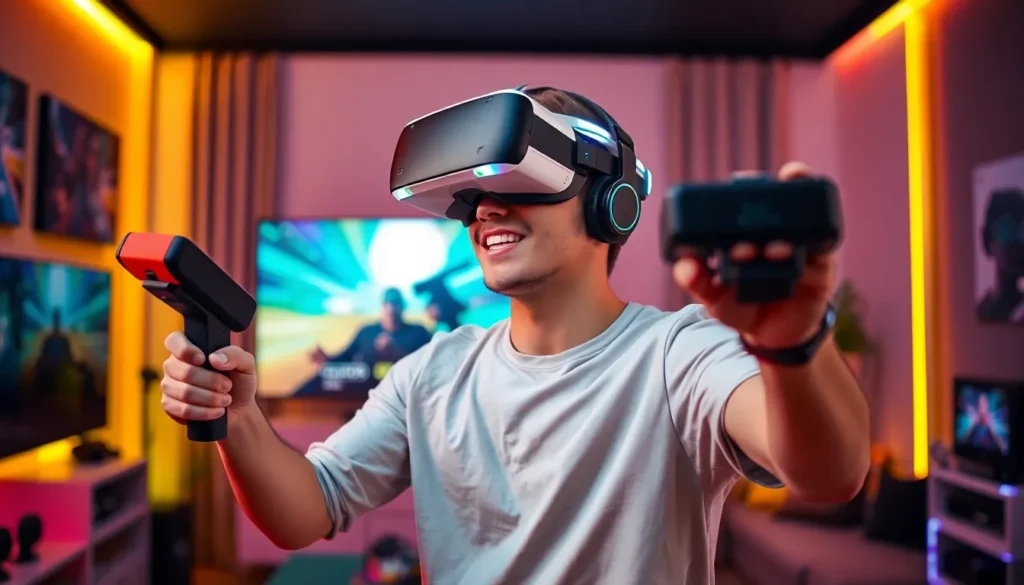Imagine slipping on a headset and being transported to a world where dragons roam and aliens invade. VR gaming technology isn’t just a trend; it’s a revolution that’s changing how players experience their favorite games. Gone are the days of sitting on the couch, munching on snacks while mindlessly pressing buttons. Now, players can physically step into their games, dodge virtual bullets, and even wield a lightsaber like a Jedi.
As VR technology evolves, so do the possibilities. It’s not just about gaming anymore; it’s about creating immersive experiences that blur the lines between reality and fantasy. Whether you’re battling zombies in a post-apocalyptic city or exploring the depths of the ocean, VR gaming offers a thrill that traditional gaming simply can’t match. So buckle up and get ready to dive into a universe where the only limit is your imagination.
Table of Contents
ToggleOverview of VR Gaming Technology
Virtual reality gaming technology immerses players in a digital environment, simulating physical presence. This technology employs headsets equipped with sensors to track movements, allowing players to engage with the game world intuitively. With graphics that create lifelike visuals, users can explore richly detailed settings that enhance their gaming experiences.
Several key components drive VR gaming. Head-mounted displays (HMD) present 3D visuals directly in the player’s line of sight. Controllers equipped with motion tracking enable precise interactions, mimicking real-world movements. Additionally, spatial audio enhances immersion, allowing players to hear sounds from various directions, enriching gameplay.
The hardware landscape includes popular VR headsets like Oculus Quest 2, HTC Vive Pro, and PlayStation VR. Each device offers unique features and performance capabilities. The advancements in processing power and display technology significantly improve resolution and refresh rates, which minimize motion blur and enhance comfort during extended play sessions.
Game developers leverage VR technology to create diverse genres, from action and adventure to simulation and horror. Notable titles include Beat Saber, Half-Life: Alyx, and VRChat, showcasing the versatility of VR experiences. Each game finds ways to fully utilize the capabilities of VR, providing players with interactive and engaging gameplay.
As VR continues to evolve, it influences various sectors beyond gaming. Applications in education, training, and therapy demonstrate the technology’s potential for wide-ranging impacts. The future of VR gaming technology promises further innovation, fostering creative gameplay experiences and redefining entertainment possibilities.
History of VR Gaming

The journey of virtual reality gaming technology spans decades, showcasing remarkable innovations and milestones.
Early Developments
In the 1960s, Ivan Sutherland created the first head-mounted display system, earning the title of “Sword of Damocles.” This device laid the groundwork for VR by allowing users to experience basic graphical environments. In the 1980s, Jaron Lanier popularized the term “virtual reality” and founded VPL Research, which developed the DataGlove and EyePhone, early VR prototypes that enabled users to interact with virtual environments. These initial efforts faced technological limitations, yet they sparked interest in immersive gaming experiences.
Evolution Through the Years
The 1990s marked significant advancements with Sega and Nintendo attempting to break into the VR market, releasing limited VR arcade games. However, these early efforts struggled with technological constraints and consumer skepticism. In the 2010s, Oculus Rift’s Kickstarter campaign reignited passion for VR, resulting in commercially viable headsets. Sony’s PlayStation VR and HTC Vive further revolutionized the scene, providing high-quality experiences and user-friendly designs. Today, VR gaming continues to progress rapidly with enhanced graphics, improved tracking systems, and broader game libraries, promising a thrilling future for players.
Key Components of VR Gaming
Virtual reality gaming technology consists of several key components that enhance the immersive experience for players. Understanding these elements provides insight into how VR fundamentally changes gameplay.
Headsets
Headsets serve as the primary interface between players and the virtual world. Quality head-mounted displays (HMD) create lifelike visuals with high resolutions and wide fields of view. Popular options, such as the Oculus Quest 2 and HTC Vive Pro, integrate advanced features like adaptive lenses and built-in audio. Effective tracking systems detect head movements in real-time, ensuring a seamless experience. Comfort matters, so ergonomic designs support extended gaming sessions. Players experience a true sense of presence as they delve into various environments.
Controllers
Controllers enable intuitive interactions within the virtual landscape. Motion-tracking technology ensures hand movements translate accurately on-screen. Users can choose from various types, including the Oculus Touch or Valve Index controllers, equipped with buttons, triggers, and haptic feedback. Enhanced ergonomics contribute to comfort and control, allowing players to wield virtual weapons or manipulate objects fluidly. These tools bridge the gap between physical actions and digital responses, offering a responsive gaming experience. Controllers play a crucial role in shaping how players navigate and engage with their virtual surroundings.
Software
Software synthesizes the VR experience by creating engaging content and environments. Game developers utilize sophisticated programming tools to build immersive worlds, ensuring fluid gameplay and rich interactivity. Titles like Half-Life: Alyx and Beat Saber showcase innovative design that captivates players. Furthermore, libraries expand regularly, featuring diverse genres catering to various interests. Compatibility across platforms, such as Oculus or SteamVR, enhances accessibility and enjoyment. The evolving software landscape continuously pushes boundaries, paving the way for groundbreaking experiences.
Advantages of VR Gaming Technology
VR gaming technology offers numerous advantages that significantly enhance the overall gaming experience. Immersion and interactivity stand out as key benefits.
Immersive Experience
Immersive experiences transport players into a digital world, creating a strong sense of presence. Players engage their senses through stunning visuals, realistic sound, and dynamic environments. VR headsets like the Oculus Quest 2 and HTC Vive Pro deliver high-definition graphics, making players feel as if they’re inside the game. Sound design also plays a crucial role, as spatial audio replicates real-world cues, enhancing realism. Engaging narratives encourage deeper emotional connections, further amplifying immersion. Titles such as Beat Saber and Half-Life: Alyx showcase how these immersive elements transform gameplay, creating unforgettable adventures.
Enhanced Interactivity
Enhanced interactivity defines VR gaming by allowing intuitive gameplay. Motion-tracking controllers make it possible for players to manipulate virtual objects naturally. Players swing swords, grab items, and interact with their surroundings, simulating real-life movements. These interactive elements foster a connection between the player and the game world, making experiences more engaging. Games like VRChat exemplify social interaction, allowing players to communicate and collaborate in real-time. Improved responsiveness of VR systems also ensures smooth transitions between actions, resulting in a seamless experience. This level of interactivity brings gaming to life in unprecedented ways.
Challenges and Limitations
VR gaming technology presents significant challenges and limitations that affect player experience and market growth.
Motion Sickness
Motion sickness remains a prevalent issue among VR users. Symptoms can include dizziness, nausea, and disorientation, impacting gameplay enjoyment. Research indicates that around 20 to 40 percent of users report symptoms, especially during fast-paced scenes or when movement doesn’t match visual cues. Developing techniques such as reducing latency and optimizing frame rates can alleviate discomfort. Additionally, increasing the user’s field of view helps maintain immersion while reducing motion sickness effects. Games designed with these considerations enable smoother transitions, enhancing overall user experience.
Cost Barriers
Cost barriers significantly limit VR gaming accessibility. Starting with headsets, prices range from $300 to over $1,000, creating financial challenges for many consumers. Lower-end systems may lack essential features, compromising immersive experiences. Game development also incurs high costs, which can affect pricing for VR titles. Many popular games can exceed $30 to $60 at launch, limiting adoption among casual gamers. Overcoming these financial obstacles often requires industry innovations that offer more affordable options without sacrificing quality. Budgets for developers can expand, leading to more competitive pricing and broader market outreach.
Future Trends in VR Gaming
VR gaming technology continues to evolve, with trends that indicate remarkable growth and innovation on the horizon.
Technological Advancements
Enhanced hardware significantly improves user experiences in VR gaming. Companies are investing in higher-resolution displays, with some headsets offering resolutions exceeding 4K. Wireless technology advances further enhance freedom of movement, allowing players to engage without cables restricting them. Developers focus on intuitive controllers equipped with haptic feedback, creating a more tactile experience. Furthermore, artificial intelligence plays a pivotal role in making NPCs (non-player characters) smarter and more responsive, enhancing immersion. Spatial audio systems also see improvements, providing realistic soundscapes that react to player movements. As these technological advancements unfold, they set the stage for truly transformative gaming experiences.
Market Predictions
Analysts forecast a promising trajectory for the VR gaming market. Projections suggest that the global VR gaming market could reach approximately $45 billion by 2027. Increasing consumer interest and expanding game libraries contribute to this anticipated growth. Adoption rates may rise as headsets become more affordable, targeting everyday gamers. Additionally, VR’s integration with social platforms enhances multiplayer engagement, encouraging collaboration among users. The rise of cloud gaming also presents new opportunities for accessibility, allowing players to enjoy VR experiences without relying on high-end hardware. This confluence of factors points toward a dynamic future that will reshape the gaming landscape in the coming years.
VR gaming technology is reshaping how players engage with virtual worlds. Its immersive nature allows for unparalleled experiences that blend reality and fantasy. As advancements continue to emerge, the potential for innovative gameplay expands, promising to captivate more gamers.
While challenges like motion sickness and cost barriers remain, ongoing developments are set to address these issues. The industry’s growth trajectory suggests a bright future, with increased accessibility and enhanced experiences on the horizon. As VR technology evolves, it will undoubtedly redefine entertainment and create new opportunities for creativity and interaction in gaming.





